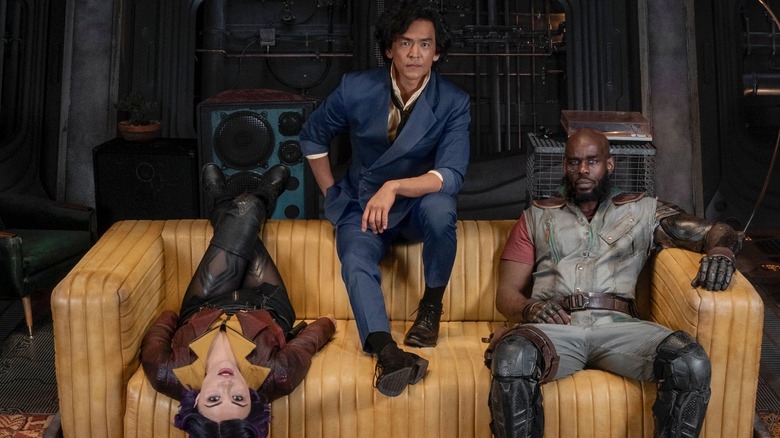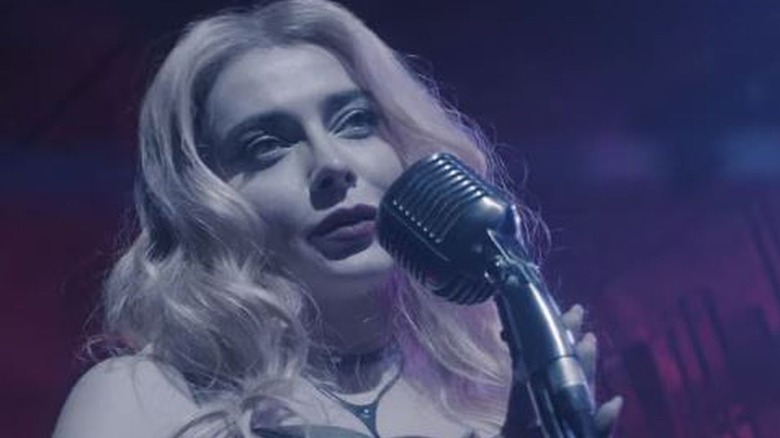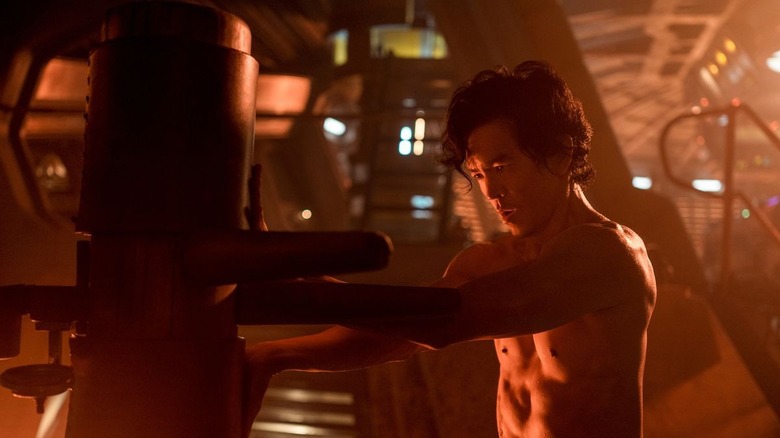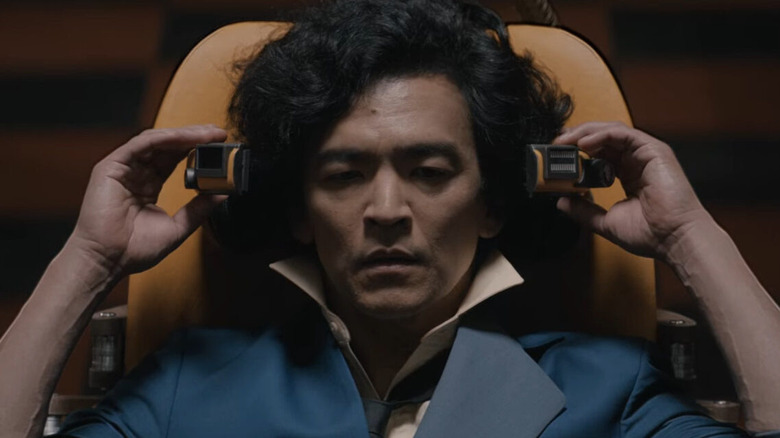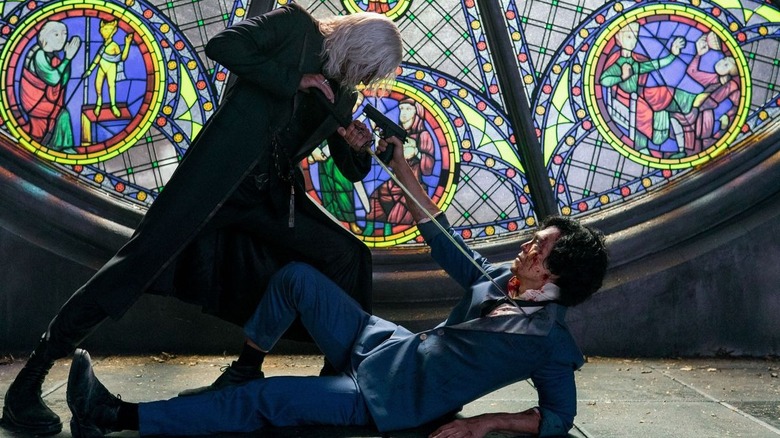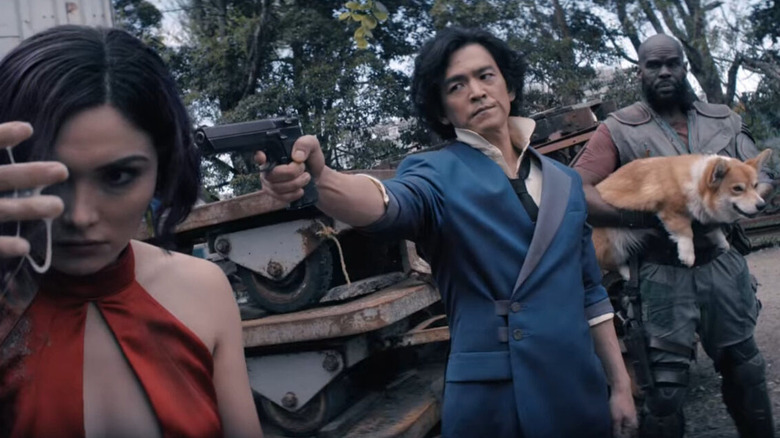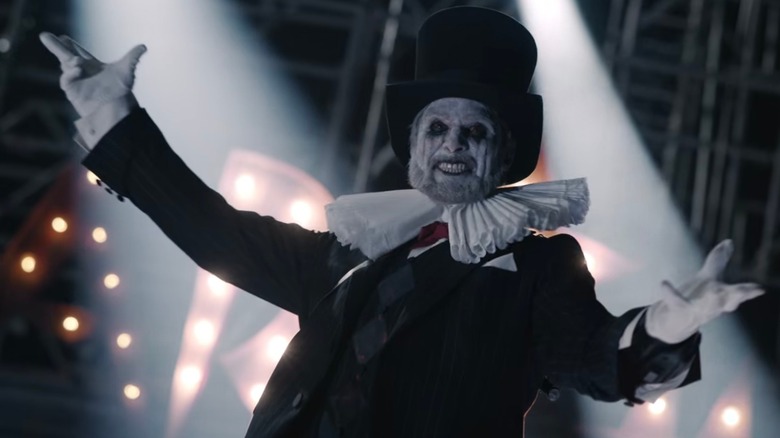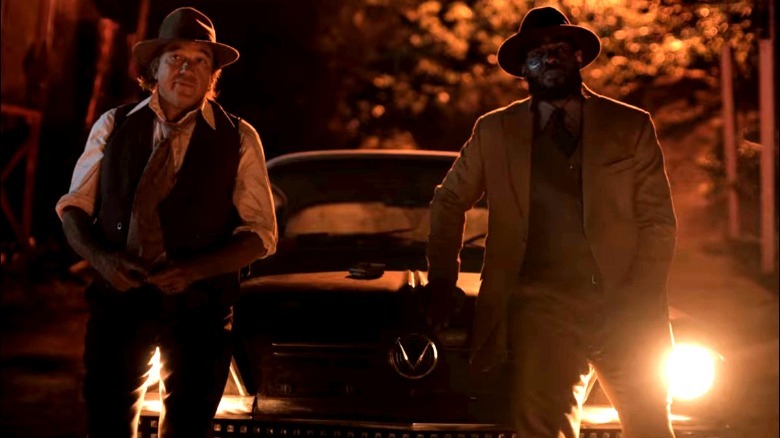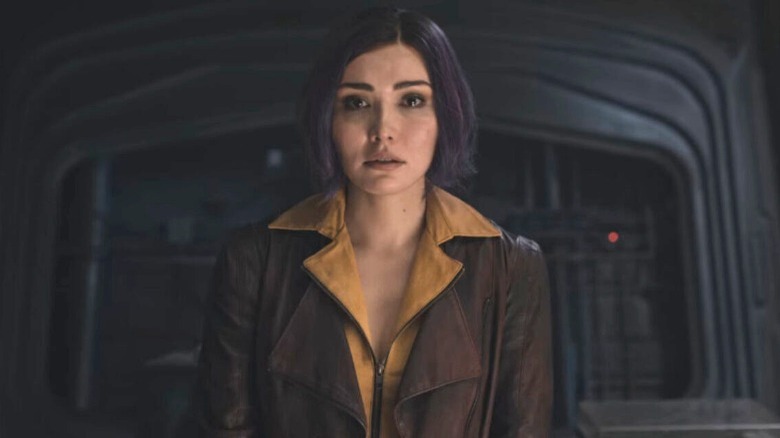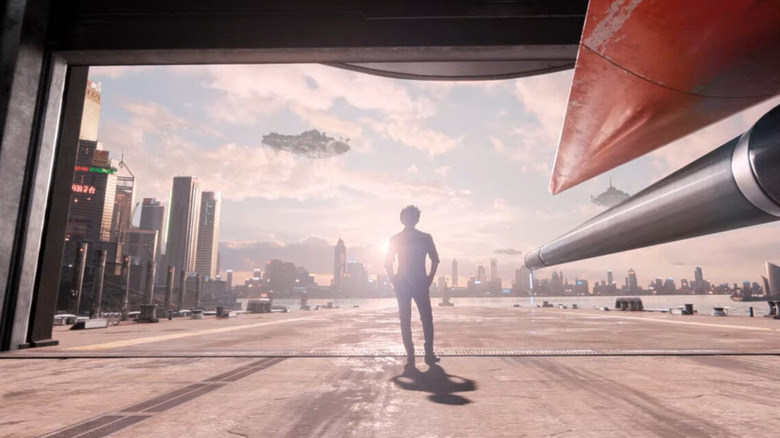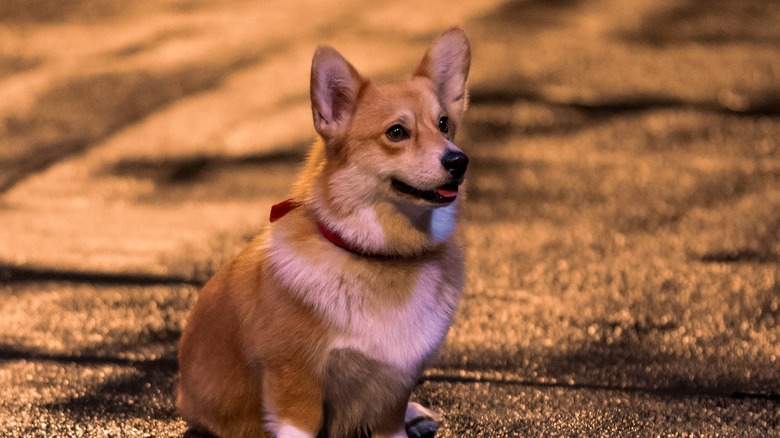The Live-Action Cowboy Bebop Episodes Ranked
In the eyes of many, the Netflix live-action remake of the classic anime "Cowboy Bebop" did not hit the jackpot. It raked in mixed to negative reviews, and many fans of the anime found the visuals did not match the kinetic and rhythmic nature of the original.
There's no dispute that the original "Cowboy Bebop," directed by Shinichirō Watanabe, written by Keiko Nobumoto, and released in 1998, is the OG behemoth, a milestone in animation history set to the jazzy music of "The Seatbelts" that elevated anime as a whole. The live-action version has the same set-up — it's still about a crew of rough and tumble bounty hunters, played here by John Cho, Mustafa Shakir, and Daniella Pineda, barely scraping by in an unfriendly galaxy — but with alterations to its characters, plot, and the anime's essence.
What is worth salvaging in this adaptation? What went wrong with it? What went right? Could some of the changes to the source material be more of a positive than a negative? Let's do an appraisal of the strengths and weaknesses of the live-action version of "Cowboy Bebop" by walking through its episodes and seeing how each one compares to the anime that many people (including this writer) love so much.
10. Blue Crow Waltz
The penultimate episode of season 1, "Blue Crow Waltz," rolls out the information dump truck, spelling out why Spike departed the Syndicate, how Julia came to know Vicious and Spike, and the mounting interferences that ripped Spike and Julia apart. We learn why Spike feels indebted to the temperamental Vicious, and get a glimpse of Vicious' overwrought daddy Issues.
On a technical level, "Blue Crow Waltz" has plenty of sequences to boast about: The seamless cuts between Spike and Julia's lovemaking and Vicious' violent assault on a rival gang member, for one, as well as Spike's one-man attack on the Neptune Cartel. Still, the episode repeats an egregious mistake that's common in live-action remakes of animated properties: explaining things best left unsaid, and revealing mysteries best left unsolved. In the anime, most of Spike's past is shrouded in mystique, witnessed in short flashbacks. The original show trusted its audience to piece together the larger picture. Given the structure of western television series, making everything more obvious was probably an inevitable change, but that doesn't make it any less cloying.
This is also the episode where the live-action "Cowboy Bebop" really tries to become more introspective, but can't do it quite as well as the anime. Even divorcing this episode from the source material, "Blue Crow Waltz" doesn't master its own dance steps, despite promising big reveals in its choreography. The script expresses the characters' thoughts, but never really dwells on them. Even with the noteworthy action sequences, an episode as important as this one should not feel so weightless and soapy.
9. Cowboy Gospel
Sadly, the "Cowboy Bebop" premiere deserves one of the lowest spots on this list. "Cowboy Gospel" makes a promise to both existing "Cowboy Bebop" fans and new viewers. It bathes its audience in visual exposition and the score by Yoko Kanno, who also scored the anime. Modeled after the opening of "Cowboy Bebop: The Movie," the first 10 minutes sweep viewers into a vibrant and oddball space western. An adrenaline-fueled payoff reveals that the action takes place in space, and builds up to Spike Spiegel's grand entrance using the countdown of a descending elevator.
Even if you spot the weaknesses in its excessive VFX, overly busy backgrounds, and hurried movement, the opening promises new adventures in the classic "Cowboy Bebop" world. However, that potential is immediately curbed when it becomes clear that "Cowboy Gospel" is a simple retread of the anime's pilot. Once again, Spike and Jet are targeting a drug dealer known as Asimov, who is assisted by his girlfriend, Katerina.
Even if you haven't experienced the original, it's cringeworthy to see Netflix attempt to simply recreate the anime, particularly the effects of the drug called Red Eye. That said, if you've never seen the original "Cowboy Bebop," you may be intrigued and entertained by its attempts to be both tragic and wacky, while if you're an existing fan who buys Cho and Shakir's chemistry, you might still be curious enough to press the "Next Episode" button.
8. Binary Two-Step
Let's face it: The Spike and Julia romance never soars as high as Spike's familial connection to the Bebop crew. In "Binary Two-Step," Spike goes hunting for Dr. Londes, an elusive bounty who may result in a large payday. In an attempt to get closer to the target, Spike hooks into a virtual reality machine, thinking that it will be simple to disconnect. The joke is on him, though: Unplugging Spike while he's in the virtual world may kill him.
A video game-esque dreamscape where Spike relives the fantasy of escaping with Julia is not inherently an awful concept. With more time and attention, it could really help Spike's arc. "Binary Two-Step" relays Spike's pain with a vague but telling reference to his sordid history as a Syndicate member, and then introduces the off-screen presence of Radical Ed, one of the anime's main characters. But Spike and Julia (or at least the Julia in Spike's VR dreams) lack chemistry. When the camera pans to Julia in Spike's mindscape, the faux reunion does not tug at the heartstrings. It's an overly rushed and busy moment, making it hard for us to absorb the atmosphere.
7. Supernova Symphony
The 1st season finale of "Cowboy Bebop" has major consequences for Spike's secrecy and his partnership with Jet. Much to Jet's outrage, his kid is held hostage by Vicious' gang. Frustrated by rifts among the group, Faye decides to leave (although she does drop back in for a last-minute rescue). As she goes, she drops a line that desperately references, and perhaps subverts, the anime's main theme: "I'm not carrying that weight." It feels like a slap in the face.
Unlike the anime's famous cathedral scene, this episode also stages a reunion between Spike and Julia, the latter miserable about Spike's long absence and his inability to save her from her marriage. Despite the leadup, her development here is suspect, as she blames Spike for leaving her with Vicious, and cornily announces that Spike is nothing more than a dream she should wake up from. While making Julia a major antagonist is fun in theory, her ascension to villainy takes away one of Spike's most poignant characteristics: He was stuck in a liminal state. Here, his fall from the cathedral, set to the music of "Green Bird," lacks spirituality. It's not about his stagnant soul, but rather lost love.
"Supernova Symphony" does have a solemn ending during which the members of team Bebop go their separate ways. But it also falls into the trap of a last-minute reveal by introducing Radical Ed onscreen. "Cowboy Bebop" has the freedom to play with mood, but Ed's appearance takes away from the meditative darkness of this suddenly fractured family, focusing more on teasing the future than the drama of the present moment.
6. Callisto Soul
Faye Valentine spends her first appearance in "Callisto Soul" rehearsing her charade, giving her character a performative air. The live-action "Cowboy Bebop" has been criticized for removing Faye's compelling insecurities, reservations, and abrasiveness. In the anime, it's a running gag — and a tragic habit — that she often ditches the Bebop crew, both because the universe has taught her to distrust attachments, and also because she has her own business to attend to.
By contrast, Daniella Pineda's Faye is out to solve her identity crisis from the get-go, rather than making that goal the result of extra character development. Depending on how you feel about Pineda's interpretation of the character, her petulant, adolescent dialogue can feel forced. However, to Pineda's credit, Faye's kid-like speech and forced attempts to sound cool come from understandable human impulses; it's like Pineda knows that her Faye never really got to grow up. Still, fans of the anime may not be thrilled about how quickly Faye warms to the rest of the Bebop crew.
"Callisto Soul" also features Maria Murdock and her dysfunctional family, who embody a pretty aged trope about extremist environmentalists. In the anime, Murdock turned her victims into monkeys. Here, they turn into wincingly conspicuous CGI trees. To the credit of "Callisto Soul," the thematic parallels between the formation of the Bebop family and the fractured Murdocks strike a sense of balance, even if you disagree with how quickly the core team comes together.
5. Sad Clown A-Go-Go
"Sad Clown A-Go-Go" begins with Vicious freeing the assassin Pierrot from his prison. In the anime, "Pierrot le Fou" is a ghastly chapter of "Cowboy Bebop," filled with nightmarish visuals and a payoff that is enigmatic in Spike's eyes. Here, Pierrot feels less like an urban legend and more like a clown cosplayer. The live-action remake lacks the artistic range to maneuver Spike through a labyrinth-like, neon-saturated carnival, and the payoff, during which Pierrot breaks down and cries, "It hurts, Mommy," lacks the tragic poignancy of its predecessor. However, for non-anime viewers, "Sad Clown A-Go-Go" might work as a dark comedy.
What does shine in this episode is that the Bebop's found family bonds have fully cemented — Jet even takes his crew bowling. The highlight of the episode is when Jet gives Spike and Faye rhyming instructions, much like a father teaching his kids. There's also a pretty funny twist in which Ein turns out to have hackable brain implants, which Pierrot exploits so that he can appear as a hologram projected from Ein's eyes.
4. Darkside Tango
This episode's three-tiered structure — Jet reuniting with his partner, Faye and Spike bonding during downtime, and Vicious formulating an alliance with another crime boss — should fit together like a neat musical triad, but "Cowboy Bebop" can't smooth out the awkward cuts between each storyline. Each one of the stories in "Darkside Tango" has elements that work on their own, but the whole thing doesn't come together, despite strong thematic connections between each plotline.
While reuniting with his old partner, Jet deals with the escaped convict he holds responsible for his bad reputation, the dissolution of his marriage, and the loss of his arm. It leads to a predictable reveal, but Shakir gamely carries Jet through his period of determination and longing. With close-ups on his introspective glances, Shakir is the star of this story, even if the episode doesn't give him enough breathing space.
While Jet is away, Faye and Spike are supposed to nab other bounties, but take their sweet time trading barbs. Their sibling-like relationship grows as they play variations on Rock, Paper, Scissors and swap insults as every potential bounty is claimed on television. The highlight? Faye proving her mettle by recalling the capture of a high-value bounty. The spot boasts a playful rhythm as Faye imagines herself a seductress, disarming her target with a sly sleight of hand with every step of her tango.
Unfortunately, the episode ends with hurried transitions that undercut the tragedy unfolding between Jet and his partner. It's a moment that will make fans wish for the anime's self-contained episodes, as opposed to the more serialized, binge-ready nature of the remake. "Darkside Tango" quickly cuts to Vicious and Julia's apartment, where Julia realizes that Spike is still alive. It's a cliffhanger that you simply don't care about, because it steals what should rightfully be Jet's ending.
3. Galileo Hustle
"Galileo Hustle" is a grade-A Bebop family episode. Faye meets her mom — or, at least, her fake mom Whitney, a scam artist who pulled the amnesiac into her scheme when a confused Faye woke from a cryogenic nap. Faye is forced to take Whitney aboard the Bebop, but when Whitney is exposed as a wanted bounty, Faye's deception angers Jet, even though he tries to be understanding.
"Galileo Hustle" also has an amusing sequence in which Jet leaves Spike to deal with some henchmen in order to holo-attend his daughter's recital. Spike fights the henchmen in the background while Jet watches the performance. It's a moment that also foreshadows upcoming rifts: Jet is frustrated with Faye's dishonesty, while Spike sticks up for her. It's revealing that Spike will protect Faye's secrecy despite the consequences, which will ultimately hurt Jet in the season finale.
It's as if "Galileo Hustle" wants to be a throwback to the more irreverent adventures in the anime, and the entire episode builds to a single punchline: Whitney orchestrated the deception just to live out a kinky fantasy of being chased by her lover. There is one thing the live-action remake robs us of, however. In the anime, Jet and Spike go on an amusing trek to retrieve a VHS player. In the Netflix version, Jet already has a VHS machine on board the Bebop. Very convenient, that.
2. Venus Pop
Spike and Jet pursue the Teddy Bomber just as Spike's past is catching up to him. Concerned, Spike pays a visit to his old friend Ana, a club owner. Tamara Tunie, who plays Ana, proves herself an asset to the growing cast as a matronly boss who keeps order and shares a warm chemistry with Cho's Spike. Her generous helpings of tough love and compassion add a lot to the series, and she works well as a parental figure who Spike secretly holds in his heart.
The crux of "Venus Swing" is Jet and Spike's partnership, which is the heart of this new series. These two men go to great lengths to save each other's lives, as seen when Spike steps on a land mine for Jet. Shakir and Cho make a compelling pair, although it's clear that Spike's secrecy is going to haunt their relationship.
Fans will be rightfully disappointed that the Teddy Bomber elements borrowed from the anime are reduced to a conventional television episode in order to make everything relevant to the overarching arc — the anime's self-contained irreverence is part of its charm. The anime's creators mischievously toy with structure and audience's expectations, to the point where the Teddy Bomber explicitly knows that the plot largely makes him irrelevant. "Venus Swing" approaches the material similarly, but the end result packs a much less hilarious punch.
1. Dog Star Swing
Jet and Spike venture out to capture Hakim, a wanted man disguised by a holo device. Jet is also on the lookout for a popular doll, which he wants to purchase for his daughter, Kimmie. Meanwhile, in a weaker subplot, Vicious is figuring out what to do with the Red Eye blowback before restarting production.
"Dog Star Swing" is the episode that's most comfortable with the live-action series' form, and introduces additions that heightens its own worldbuilding: the seafood truck where Spike converses with an informant, for example, or Spike communicating with Vicious by grazing his cheek with a shot from a sniper rifle, as if he's slapping his former friend on the cheek from miles away.
When it's revealed that Hakim is a dog-napper who cannot murder the critters he promised himself he'd annihilate, the ending becomes like a Saturday morning cartoon with an eccentric twist. Hakim's quest for vengeance on the upper-crust is a bust. If there's anything that the live-action "Cowboy Bebop" deserves credit for, it's making the antagonists-of-week feel like they believe themselves to be the underdogs of their own stories.
Kanno's cheeky score enhances the comedy as well, especially as we watch Kimmie's doll fall into dirty water as Jet grabs Spike's ankle in the background. It's a visual extension of Spike and Jet's bond, and one of the few scenes that feels like it's straight from the anime, especially when a dangling Spike lights and smokes a cigarette as he waits for an indignant Jet to hoist him up. Also, there's one change that die-hard anime fans and new viewers should both agree on: Seeing Ein played by real, fuzzy corgi is great.
